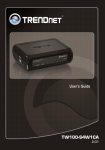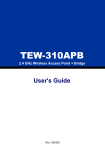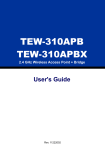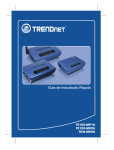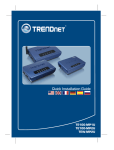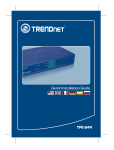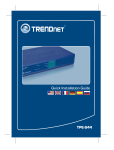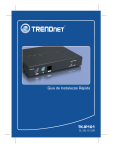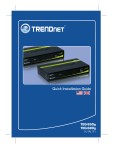Download AOpen 4-Port 10/100Mbps Ethernet Broadband Router User`s guide
Transcript
FCC Warning This equipment has been tested and found to comply with the limits for a Class B digital device, pursuant to Part 15 of the FCC Rules. These limits are designed to provide reasonable protection against harmful interference in a commercial environment. This equipment generates, uses and radiates radio frequency energy. If not installed and used in accordance with the instructions, it may cause harmful interference to radio communications. Operation of this equipment in a residential area is likely to cause harmful interference. In this case the user will be required to correct the interference at their own expense. CE Mark Warning This is a Class B product. In a domestic environment, this product may cause radio interference, in which case the user may be required to take adequate measures. VCCI Warning P/N: Rev.A1-01 2 TABLE OF CONTENTS About This Guide ...............................................................................................................1 Purpose ..........................................................................................................................1 Overview of this User’s Guide......................................................................................1 Introduction ........................................................................................................................3 Applications: .................................................................................................................3 Features: ........................................................................................................................4 Unpacking and Setup .........................................................................................................5 Unpacking .....................................................................................................................5 Setup ..............................................................................................................................5 Hardware Installation .........................................................................................................7 Front Panel ....................................................................................................................7 Rear Panel......................................................................................................................8 Hardware connections ...................................................................................................9 Connect the Internet Broadband Router ..................................................................9 Check the installation .............................................................................................10 PC Network TCP/IP Setting.............................................................................................11 Windows 95/98/ME ....................................................................................................11 Windows XP/2000 ......................................................................................................13 Windows NT4.0 ..........................................................................................................14 Internet Broadband Router Configuration .......................................................................15 Login to the Internet Broadband Router .....................................................................15 Quick Setup .................................................................................................................16 Advanced Setup...........................................................................................................19 Technical Specifications ..................................................................................................34 LIMITED WARRANTY .................................................................................................35 ABOUT THIS GUIDE Congratulations on your purchase of this Cable/DSL 4-port Broadband Router. This device integrates 100Mbps Fast Ethernet and 10Mbps Ethernet network capabilities. This router is a complete solution for sharing the Internet and other office resources. Purpose This manual discusses how to install the 4-port Broadband Router. Overview of this User’s Guide Introduction. Describes the Broadband Router and its features. Unpacking and Setup. Helps you get started with the basic installation of the Router. Identifying External Components. Describes the front panel, rear panel, and LED indicators of the Router. Connecting the Router. Explains how you connect the Router to your xDSL/Cable Modem. Technical Specifications. Lists the technical (general, physical and environmental, performance and Routers settings) specifications of the Broadband Router. 1 INTRODUCTION With the explosive growth of the Internet, accessing information and services at any time, day or night, has become standard fare for most people. The era of the standalone PC is waning. Networking technology is moving out of the exclusive domain of corporations and into homes with at least two computers. Broadband network access is also gaining ground. Allowing more than two computers to access the Internet at the same time, however, has typically entailed significantly higher costs. Thus, there is a great demand for technology that enables users to share a single Internet connection. Employing a router to share an Internet connection solves the problem of high network access costs. Using such a device, each networked computer is able to make full use of broadband capabilities. This device not only comes equipped with a wide range of features but also can be installed and configured right out of the box. This device supports a simple local area network and Internet access sharing. A local area network connects home computers and enables users to access the Internet, share resources, and play online games – the essentials of the family computing lifestyle. Online gaming: Your local area network allows you to play online games and use ecommerce services. Firewall: A built-in firewall function protects against hackers. Features: ¾ ¾ ¾ ¾ ¾ ¾ ¾ ¾ ¾ ¾ High speed data transfer rate, FTP up to 40Mbps Supports NAT (sharing one IP address with all LAN users) Supports PPPoE and PPTP protocol for Dial-Up ADSL Supports DHCP Server / Client Supports UPnP (Universal Plug and Play) Supports virtual server mapping Supports packet filtering Simple Firewall protection Upgradeable firmware for future functions Easy configuration via Web Browser. Applications: Broadband Internet access sharing: Enable several computers to share a single high-speed broadband Internet connection (LAN and WAN-Internet). Resource sharing: Share printers, scanners, and other peripherals. File sharing: Exchange data, messages, and files -- thus making good use of hard disk space. 3 4 UNPACKING AND SETUP This chapter provides unpacking and setup information for the Broadband Router. Unpacking The box should contain the following items: One 4-port High Speed Broadband Router One external power adapter (5V DC, 800mA) One CD-ROM with User’s Guide Quick Installation Guide If any item is found missing or damaged, please contact your local reseller for replacement. Setup The setup of the Broadband Router can be performed using the following steps: The power outlet should be within 1.82 meters (6 feet) of the Broadband Router. Visually inspect the DC power jack and make sure that it is connected securely to the power adapter. Make sure that there is proper heat dissipation from and adequate ventilation around the Broadband Router. Do not place heavy objects on the Broadband Router. 5 The port 1 - 4 indicators light green when they’re connected to a 100Mbps Fast Ethernet station. If the indicator blinks green, the corresponding LAN port is transmitting or receiving data. HARDWARE INSTALLATION Front Panel The figure below shows the front panel of the Broadband Router. Rear Panel The figure below shows the rear panel of the Broadband Router. 4-Port 10/100Mbps Ethernet Broadband Router Front Panel POWER This indicator lights green when the hub is receiving power. Otherwise, it is off. STATUS This indicator blinks red when the Internet Broadband Router is successfully working. If the indicator is either always on or off, the Internet Broadband Router is not working properly. WAN This indicator lights green when the WAN port is connected to an xDSL/Cable modem successfully. This indicator blinks green while the WAN port is transmitting data to or receiving data from the xDSL/Cable modem. 4 Port 10/100Mbps Ethernet Broadband Router Rear Panel WAN On the 4 port broadband router, there is an RJ-45 10/100Mbps AutoMDIX WAN port. This port connects to your xDSL/Cable modem. LAN (1-4) Four RJ-45 10/100Mbps Auto-MDIX ports for connecting to either 10Mbps or 100Mbps Ethernet connections. RESET Use a pin-shaped object to reset this device to factory default settings. Resetting the device will also reset the login password to the default. LAN (Link/ACT) 7 8 Check the installation The LEDs of the Internet Broadband Router are clearly visible and the status of the network link can be seen immediately: 1. Once the device is connected to the broadband modem and the Power is connected, the Power, System, LAN and WAN port link LEDs of the Internet Broadband Router will light up. 2. If the WAN port is linked to the ADSL/Cable modem, the WAN port’s Link/ACT LED will light up. 3. If the LAN port is linked to the computer system, the LAN port’s Link/ACT LED will light up. Hardware connections Connect the Internet Broadband Router 1. Connect one end of the network cable to the WAN port of the 4-port Internet Broadband Router. 2. Connect the other end of the network cable to the Ethernet port of the xDSL or Cable modem. 3. Connect one end of another network cable to the computer’s Ethernet card and the other end of the cable to one of the Router’s LAN ports. Since the Internet Broadband Router has four ports, you can connect up to four computers directly to the unit. You do not have to buy a switch to connect these computers since the Internet Broadband Router functions as both an Internet connection-sharing unit and as a switch. 9 10 PC NETWORK TCP/IP SETTING 4. Click on the DNS configuration tab and select “Disable DNS”. 5. Click on the Gateway tab. If there are any Installed gateways, select the gateway and click Remove. The network TCP/IP settings differ based on the computer’s operating system (Win95/98/ME/NT/2000/XP) and are as follows. Windows 95/98/ME 1. 2. 3. Right click on the “Network neighborhood” icon and select properties. Select the TCP/IP for your Ethernet adapter and then click properties. Select “Obtain an IP address automatically” in the “IP Address” tab. 6. Click OK. 11 12 Windows NT4.0 Windows XP/2000 1. 2. 3. 4. 5. 6. Right click My Network Places and select Properties Double-click on the Local Area Connection icon and click Properties. Click on Internet Protocol (TCP/IP) and select Properties. Select Obtain an IP Address Automatically. Select Obtain DNS Server Address Automatically. Click OK. 13 Click on the “Start” button located on the lower left corner of the menu bar. Select “Settings” and then “Control panel.” In the “Control panel” window, select “Network” to enter the TCP/IP settings window. 1. Set “IP address” to “Obtain an IP address automatically.” 2. Set “DNS” to “Disable DNS.” 14 INTERNET BROADBAND ROUTER CONFIGURATION Quick Setup First, make sure that the network connections are functioning normally. This Internet Broadband Router can be configured using Internet Explorer 5.0 or later. On the main webpage, select “Quick Setup” to specify the Time Zone and the WAN connection type. Login to the Internet Broadband Router 1. 2. Open Internet Explorer 5.0 or higher. Enter http://192.168.0.1 (the factory-default IP address setting) in the address bar. 3. When the following dialog box appears, type in admin for the user name. Leave the password field blank, (by default, there is no password) and click LOGIN. 1-1 Time Zone Select the appropriate time zone so your system clock can synchronize itself through the SNTP Server. 1-2 WAN Connection Type To select the WAN connection-type, click Dynamic IP (Cable Modem), Static IP (Fixed-IP), PPPoE (Dial-up xDSL) or PPTP Note: If you need to set a password, refer to the Administrator Settings in Advanced Setup. 4. Two setup options appear: Quick Setup or Advanced Setup. It is recommended that you use Quick Setup if you are a beginner. It will lead you through the configuration step-by-step. 15 16 1-2-1 Dynamic IP (Cable Modem) To connect to a Dynamic IP (Cable Modem) Internet connection with the Broadband Router, check the cable modem with the related user’s guide. The Cable modem will automatically configure itself, and the Broadband Router is configured to automatically assign addresses to each PC. If required by your ISP, input a host name and MAC address. 1-2-2 Static IP If your Internet Service Provider (ISP) has assigned you a fixed IP address, select this option. Enter the assigned IP address, subnet mask, and gateway IP for your Broadband Router. 1-2-3 PPPoE (Dial-up xDSL) If your DSL Internet connection is PPPoE (Dial-up xDSL), your ISP will provide a Password and Username. Select this option, and enter the required information. If your ISP provides a Service Name, enter it in the Service Name field. Otherwise, leave it blank. 17 The Service Name, IP Address, and DNS Address fields must be completed if your ISP provided you with this information. If your ISP Provider provides a Dynamic IP Address, you should skip these fields. The MTU feature specifies the largest packet size permitted for network transmission. Enter the value desired; for most DSL users, 1492 is recommended. By default, MTU is set at 1492. The Maximum Idle Time feature can control the connection time if you want to reduce connection fees charged by your ISP (default time=0, always connect). Check the Connect-on-demand box to enable your router to connect your ISP whenever an Internet connection is required. 1-2-4 PPTP If connecting to the Internet using a PPTP xDSL Modem, enter the PPTP Account Name, PPTP Password, Host Name, Service IP Address, your IP Address, and your Subnet Mask as provided by your ISP in the appropriate fields. If your ISP has provided you with a Connection ID, enter it in the Connection ID field. Otherwise, leave it blank. The MTU feature specifies the largest packet size permitted for network transmission. Enter the value desired; for most DSL users, 1492 is recommended. By default, MTU is set at 1492. The Maximum Idle Time feature can 18 control the connection time (default time=0, always connect). Check the Connect-on-demand box to enable your router to connect your ISP whenever an Internet connection is required. 1-3 DNS The Domain Name System (DNS) is the way that Internet domain names are translated into Internet Protocol (IP) addresses. If your ISP provided at least one DNS Server IP Address, type that IP Address in the Primary DNS address fields. You may also enter another DNS Server IP Address; the Router will utilize these simultaneously for quicker access to functioning DNS Servers. Advanced Setup The Broadband Router supports advanced functions like System settings, WAN settings, LAN settings, NAT Settings, and Firewall settings. 2-1 System This page includes all of the basic configuration tools for the Broadband Router. Choose from the selections on the left side of the menu screen. 19 2-1-1 System Time Connecting to a Simple Network Time Protocol (SNTP) server allows the Broadband Router to synchronize the system clock to the global Internet time through the SNTP Server. The synchronized clock in the Broadband Router is used to record the system log and control client filtering. 2-1-2 Administrator Settings • Password Settings Set a password if you wish to restrict management access to the Broadband Router. • Remote Management via the Internet To manage the Broadband Router from a remote location (outside of the local network), you must specify the IP address of the remote PC. Leave the IP address as 0.0.0.0, to allow open access to the router. 20 2-1-3 Firmware Upgrade Upgrading firmware for this Broadband Router improves functionality and performance. Enter the path and name of the upgrade file then click the APPLY button below. You will be prompted to confirm the upgrade. While updating the firmware, please wait after pressing the APPLY button, and follow the instructions on the screen; the System Light on the front panel will start blinking when the firmware has been upgraded successfully. 2-1-4 Configuration Tools Use the "Backup Settings" tool to save the Broadband Router's current configuration to a file named "config.bin" on your PC. You can then use the "Restore Settings" tool to restore the saved configuration of the Broadband Router that was set previously. Select "Restore to Factory Defaults" tool to force the Broadband Router to reset and restore the original factory settings. • To restore the factory default settings of the Broadband Router, select the “Restore Factory Default Configuration” option. • Backup Settings Select the “Backup Settings” option to save the current settings in a file called “config.bin,” or save to a filename of your choosing. • Restore Settings To restore the backup file to the Broadband Router, enter the path and filename of the backup file (i.e. config.bin). 2-1-5 Status The status screen will display the Broadband Routers' WAN/LAN interfaces, firmware and hardware version numbers, and the number of connected clients to the network. 2-1-6 System Log View any attempts that have been made to gain access to the network. Restore Factory Default 21 22 2-1-7 Reset 2-2 WAN The Broadband Router supports the following types of Internet connections: Dynamic IP Address, Static IP Address, PPPoE, and PPTP. 2-2-1 Dynamic IP The Host Name is optional, but may be required by some Service Providers. The default MAC address is set to the WAN's physical interface on the Broadband Router. If the Service Provider requires the MAC address, type it in. Click the "Clone MAC Address" button to copy the MAC address of the Network Interface Card installed in the PC. The WAN MAC address will be replaced by this MAC address. If your ISP is BigPond (Australia), check the Enable box. 23 2-2-2 Static IP If the Service Provider has assigned a fixed IP address, enter the assigned IP address subnet mask and gateway address provided. Click “yes” if are using two or more IP addresses. 2-2-3 PPPoE (Dial-up xDSL) If you’re connecting to the Internet using a PPPoE (Dialup xDSL) Modem and your ISP has provided you with a Password and Username, then your ISP uses PPPoE. Select this option, and enter the required information. If the ISP provided a Service Name, enter it in the Service Name field. Otherwise, leave it blank. The Service Name, IP Address, and DNS Address fields must be completed if your ISP provides you with this information. If your ISP provides a Dynamic IP Address, skip these fields. 24 The MTU feature specifies the largest packet size permitted for network transmission. Enter the value desired; for most DSL users, 1492 is recommended. By default, MTU is set at 1492. The Maximum Idle Time feature can control the connection time (default time=0, always connect). Check the Connect-on-demand box to enable your router to connect your ISP whenever an Internet connection is required. 2-2-4 PPTP If connecting to the Internet using a PPTP Modem, enter the PPTP Account Name, PPTP Password, Host Name, Service IP Address, your IP Address, and your Subnet Mask as provided by your ISP in the appropriate fields. If your ISP has provided you with a Connection ID, enter it in the Connection ID field. Otherwise, leave it blank. The MTU feature specifies the largest packet size permitted for network transmission. Enter the value desired; for most DSL users, 1492 is recommended. By default, MTU is set at 1492. The Maximum Idle Time feature can control the connection time (default time=0, always connect). Check the Connect-on-demand box to enable your router to connect your ISP whenever an Internet connection is required. 2-2-5 DNS The Domain Name System (DNS) is the way that Internet domain names are translated into Internet Protocol (IP) addresses. 25 If your ISP provided at least one DNS Server IP Address, type that IP Address in the Primary DNS address fields. You may also enter another DNS Server IP Address; the Router will utilize these simultaneously for quicker access to functioning DNS Servers. 2-2-6 Dynamic DNS The Dynamic DNS feature allows you to host a server (Web, FTP, Game Server, etc.) using a host name with your dynamically assigned IP address. Most broadband Internet Service Providers assign dynamic IP addresses. When you use a Dynamic DNS service provider, your friends can enter your host name to connect to your server, no matter what your IP address is. • Use Dynamic DNS Check this option to enable Dynamic DNS. • Service Provider Select a Dynamic DNS service provider from the dropdown list. • Host Name Enter the host name your Dynamic DNS service provider has assigned to you; for example: myhost.mydomain.net. • User Name 26 Enter the username provided by your Dynamic DNS service provider. • Password Enter the password provided by your Dynamic DNS service provider. 2-3 LAN To set the LAN’s IP Address. 2-3-1 LAN Settings The default value is 192.168.0.1 for the IP address and 255.255.255.0 for the Subnet Mask. You may change the value according to your needs. To enable the DHCP server to allocate dynamic IP addresses to the clients PCs, click “Enable”. The client can get an IP Address that is between the IP Pool Starting Address and the IP Pool Ending Address. You may also change the IP Pool range value. The Lease Time is the amount of time a network user will be allowed to connect to the Router with his/her current dynamic IP address. Enter the amount of time, in hours, days or weeks, which the user will be “leased” this dynamic IP address. You can enter your local domain name in the Local Domain Name fields. 2-3-2 DHCP Client List The DHCP client list allows you to see which clients are connected to the router via IP address, host name, and MAC address. 27 2-4 NAT Network Address Translation (NAT) allows multiple users at the local site to access the Internet through a single public IP address. NAT can also prevent hacker attacks by mapping local addresses to public addresses for key services such as the Web or FTP. 2-4-1 Special Application Some applications require multiple connections, such as Internet gaming, video conferencing, and Internet telephony. These applications cannot work when Network Address Translation (NAT) is enabled. When users send this type of request to your network via the Internet, the Router will forward those requests to the appropriate PC. If you need to run applications that require multiple connections, specify the port normally associated with an application in the "Trigger Port" field, select the protocol type as TCP or UDP, then enter the public ports associated with the trigger port to open them for inbound traffic. • TCP (Transmission Control Protocol) - A method (protocol) used along with the Internet Protocol (Internet Protocol) to send data in the form of message units between computers over the Internet. While IP takes care of handling the actual delivery of the data, TCP takes care of keeping track of the individual units of data (called packets) that a message is divided into for efficient routing through the Internet. • UDP (User Datagram Protocol) - A communications method (protocol) that offers a limited amount of service when messages are exchanged between computers in a network that use the Internet Protocol (IP). UDP is an alternative to the TCP and, together with IP, is sometimes referred to as UDP/IP. Like the Transmission Control Protocol, UDP uses the Internet Protocol to actually get a data unit (called a datagram) from one computer to another. Unlike TCP, however, UDP does not provide the service of dividing a message into packets (datagrams) and reassembling it at the other end. 28 Specifically, UDP doesn't provide sequencing of the packets that the data arrives in. This means that the application program that uses UDP must be able to make sure that the entire message has arrived and is in the right order. Network applications that want to save processing time because they have very small data units to exchange (and therefore very little message reassembling to do) may prefer UDP to TCP. Example: ID Trigger Port Trigger Type Public Port Public Type Comment 1 28800 UDP 2300-2400, 47624 UDP MSN Game Zone 2 28800 UDP 2300-2400, 47624 TCP MSN Game Zone 3 6112 UDP 6112 UDP Battle.net 29 2-4-2 Virtual Server The virtual server option allows you to define port number on your router for redirection to an internal LAN IP address. This feature is useful for hosting online services such as FTP or Web servers. Example: ID Server IP Mapping Port Type Comment 1 192.168.0.20 80 TCP Web Server 2 192.168.0.12 20 TCP FTP Server 3 192.168.0.12 21 TCP FTP Server 4 192.168.0.28 23 TCP Telnet Server 30 2-5-2 Client Filtering To block certain client PCs from accessing the Internet: You can filter Internet access for local clients based on IP addresses, application types, (i.e., HTTP port), and time of day. For example, this screen shows that clients in the address range 192.168.0.50-99 are permanently restricted from using FTP (Port 21), while clients in the address range 192.168.0.110-119 are blocked from browsing the Internet (port 80) from Monday to Friday and from 0:00AM to 11:00 PM. Example: 2-5 Firewall The Broadband Router provides extensive firewall protection by restricting connection parameters to limit the risk of hacker attacks and by defending against a wide array of common hacker attacks. The Broadband Router provides packet filtering rules by restricting service ports, IP address or MAC address. However, for applications that require unrestricted access to the Internet, you may configure a specific client/server as a demilitarized zone (DMZ). 2-5-3 MAC Address Control MAC Address Control allows you to block certain client PCs from accessing the Internet based on MAC addresses. 2-5-1 Discard PING from WAN side When "Discard Ping from WAN side" is checked, it is causes the public WAN IP address on the Broadband Router to ignore ping commands. Pinging public WAN IP addresses is a common method used by hackers to test whether the WAN IP address is valid. 31 32 2-5-4 DMZ (Demilitarized Zone) If a local client PC cannot run an Internet application properly from behind the NAT firewall, open the client up to unrestricted two-way Internet access by defining a PC as a virtual DMZ Host. TECHNICAL SPECIFICATIONS General Standards IEEE 802.3 10BASE-T Ethernet IEEE 802.3u 100BASE-TX Fast Ethernet ANSI/IEEE 802.3 Auto-negotiation 2-6 Routing 2-6-1 Static Routing Static routing determines the path that data follows over your network before and after it passes through your router. You can use static routing to allow different IP domain users to access the Internet through the device Protocol CSMA/CD Data Transfer Rate Ethernet: 10Mbps (half duplex), 20Mbps (full-duplex) Topology Star Network Cables 10BASET: 2-pair UTP Cat. 3,4,5 (100 m), EIA/TIA- 568 100ohm STP (100 m) Fast Ethernet: 100Mbps (half duplex), 200Mbps (full- duplex) 100BASE-TX: 2-pair UTP Cat. 5 (100 m), EIA/TIA-568 100-ohm STP (100 m) Number of Ports LAN: 4 x 10/100Mbps Auto-MDIX Fast Ethernet port WAN: 1 x 10/100Mbps Auto-MDIX Fast Ethernet port Physical and Environmental 33 DC inputs Switching Power 5V 800mA or Linear Power 9V 800mA Power Consumption 3W (Max) Temperature Operating: 0° ~ 40° C, Storage: -10° ~ 70° C Humidity Operating: 10% ~ 90%, Storage: 5% ~ 90% Dimensions 154 x 110 x 33mm (6 x 4.3 x 1.3 inches) EMI: FCC, CE 34 LIMITED WARRANTY TRENDnet warrants its products against defects in material and workmanship, under normal use and service, for the following lengths of time from the date of purchase. TW100-S4W1CA Five years If a product does not operate as warranted above during the applicable warranty period, TRENDnet shall, at its option and expense, repair the defective product or deliver to customer an equivalent product to replace the defective item. All products that are replaced will become the property of TRENDnet. Replacement products may be new or reconditioned. TRENDnet shall not be responsible for any software, firmware, information, or memory data of customer contained in, stored on, or integrated with any products returned to TRENDnet pursuant to any warranty. There are no user serviceable parts inside the product. Do not remove or attempt to service the product through any unauthorized service center. This warranty is voided if (i) the product has been modified or repaired by any unauthorized service center, (ii) the product was subject to accident, abuse, or improper use (iii) the product was subject to conditions more severe than those specified in the manual. Warranty service may be obtained by contacting TRENDnet office within the applicable warranty period for a Return Material Authorization (RMA) number, accompanied by a copy of the dated proof of the purchase. Products returned to TRENDnet must be pre-authorized by TRENDnet with RMA number marked on the outside of the package, and sent prepaid, insured and packaged appropriately for safe shipment. 35 WARRANTIES EXCLUSIVE: IF THE TRENDNET PRODUCT DOES NOT OPERATE AS WARRANTED ABOVE, THE CUSTOMER’S SOLE REMEDY SHALL BE, AT TRENDNET’S OPTION, REPAIR OR REPLACEMENT. THE FOREGOING WARRANTIES AND REMEDIES ARE EXCLUSIVE AND ARE IN LIEU OF ALL OTHER WARRANTIES, EXPRESSED OR IMPLIED, EITHER IN FACT OR BY OPERATION OF LAW, STATUTORY OR OTHERWISE, INCLUDING WARRANTIES OF MERCHANTABILITY AND FITNESS FOR A PARTICULAR PURPOSE. TRENDNET NEITHER ASSUMES NOR AUTHORIZES ANY OTHER PERSON TO ASSUME FOR IT ANY OTHER LIABILITY IN CONNECTION WITH THE SALE, INSTALLATION, MAINTENANCE OR USE OF TRENDNET’S PRODUCTS. TRENDNET SHALL NOT BE LIABLE UNDER THIS WARRANTY IF ITS TESTING AND EXAMINATION DISCLOSE THAT THE ALLEGED DEFECT IN THE PRODUCT DOES NOT EXIST OR WAS CAUSED BY CUSTOMER’S OR ANY THIRD PERSON’S MISUSE, NEGLECT, IMPROPER INSTALLATION OR TESTING, UNAUTHORIZED ATTEMPTS TO REPAIR OR MODIFY, OR ANY OTHER CAUSE BEYOND THE RANGE OF THE INTENDED USE, OR BY ACCIDENT, FIRE, LIGHTNING, OR OTHER HAZARD. LIMITATION OF LIABILITY: TO THE FULL EXTENT ALLOWED BY LAW TRENDNET ALSO EXCLUDES FOR ITSELF AND ITS SUPPLIERS ANY LIABILITY, WHETHER BASED IN CONTRACT OR TORT (INCLUDING NEGLIGENCE), FOR INCIDENTAL, CONSEQUENTIAL, INDIRECT, SPECIAL, OR PUNITIVE DAMAGES OF ANY KIND, OR FOR LOSS OF REVENUE OR PROFITS, LOSS OF BUSINESS, LOSS OF INFORMATION OR DATE, OR OTHER FINANCIAL LOSS ARISING OUT OF OR IN CONNECTION WITH THE SALE, INSTALLATION, MAINTENANCE, USE, PERFORMANCE, FAILURE, OR INTERRUPTION OF THE POSSIBILITY OF SUCH DAMAGES, AND LIMITS ITS LIABILITY TO REPAIR, REPLACEMENT, OR REFUND 36 OF THE PURCHASE PRICE PAID, AT TRENDNET’S OPTION. THIS DISCLAIMER OF LIABILITY FOR DAMAGES WILL NOT BE AFFECTED IF ANY REMEDY PROVIDED HEREIN SHALL FAIL OF ITS ESSENTIAL PURPOSE. Governing Law: This Limited Warranty shall be governed by the laws of the state of California. Note: AC/DC Power Adapter, Cooling Fan, and Power Supply carry 1-Year Warranty 37 38





















